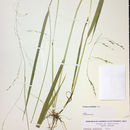More info for the terms:
association,
fern,
forest,
vineBearded fescue is a member of maple-quaking aspen (Acer spp.-Populus
tremuloides), quaking aspen-mountain brush, and aspen-spruce-fir
(Picea-Abies spp.) communities in the mountains of northern Utah [
24].
It is found in stands dominated by Gambel oak (Quercus gambelii) in Red
Butte Canyon, Utah [
4].
Bearded fescue is found in upland coastal redwood (Sequoia sempervirens)
forests of northern California and montane coniferous forests of the
Sierra Nevada, California [
15,
17].
Bearded fescue is commonly found in the Sitka spruce/devil's club (Picea
sitchensis/Oplopanax horridus) association in British Columbia and the
Pacific Northwest [
1]. It is also found in the coastal Douglas-fir
(Pseudotsuga menziesii var. menziesii) and western hemlock (Tsuga
heterophylla) zones of British Columbia [
19]. On the Saturna Island
Ecological Reserve, British Columbia, bearded fescue is a member of a
virgin Douglas-fir forest [
22].
Bearded fescue is a common understory species in red alder (Alnus rubra)
communities in the central Oregon Coast Range [
3]. In Washington,
bearded fescue occurs in western hemlock/vanillaleaf (Achlys triphylla),
western hemlock/devil's club, red alder/salmonberry (Alnus rubra/Rubus
spectabilis), and Pacific silver fir (Abies amabilis)/devil's club
associations [
6]. At Mount St. Helens, Washington, in the airfall area
(the area surrounding the immediate devastated area), bearded fescue is
one of the dominant riparian herbs [
16].
Species commonly associated with bearded fescue not previously mentioned
in Distribution and Occurrence include noble fir (Abies procera),
Alaska-cedar (Chamaecyparis nootkatensis), vine maple (Acer circinatum),
dwarf Oregon-grape (Berberis nervosa), red huckleberry (Vaccinium
parviflorum), Alaska blueberry (V. alaskensis), baldhip rose (Rosa
gymnocarpa), salal (Gaultheria shallon), western fescue (Festuca
occidentalis), blue wildrye (Elymus glaucus), evergreen violet (Viola
sempervirens), twinflower (Linnaea borealis), bunchberry (Cornus
canadensis), oneleaf foamflower (Tiarella unifoliata), sweet-scented
bedstraw (Galium trifolium), starry Solomon-seal (Smilacina stellata),
thimbleberry (Rubus parviflorus), California hazel (Corylus cornuta var.
californica), oceanspray (Holodiscus discolor), Oregon oxalis (Oxalis
oregana), western sword fern (Polystichum munitum), and bracken fern
(Pteridium aquilinum) [
1,
3,
6,
18,
22].

